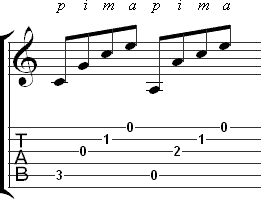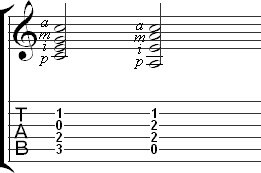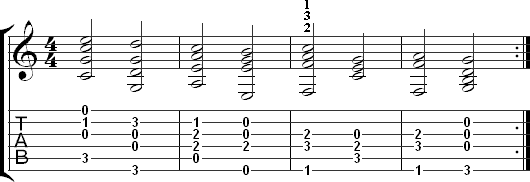What You Should Know
What You Will Learn
- Basic right and left hand technique
- How to decide whether you should use fingernails, fingerpicks, or the bare flesh of your fingers
- Right hand fingering
- Basic chord exercises
Beginning Fingerstyle Guitar
Fingerstyle guitar is an approach to playing guitar where the fingers of the right hand are used to pluck the strings. This allows you to play multiple parts at once, such as a bass line, accompaniment, and melody. The technique is very versatile and can be applied to almost any style, including blues, jazz, Celtic, rock, classical, and more.
The Instrument
Most fingerstyle music is played on an acoustic guitar, although it is possible to use an electric guitar. Jeff Beck and Mark Knopfler are two guitarists who play fingerstyle on an electric. However, their style is quite different from what is generally considered fingerstyle. If you are serious about learning fingerstyle, you should use an acoustic.
A nylon or steel string guitar can be used for fingerstyle music. Both work equally well for a lot of music, but they do have their strengths and weaknesses. Which you choose will depend on your interests. The table below lists pros and cons of each:
| Pros | Cons | |
|---|---|---|
| Nylon string |
|
|
| Steel string |
|
|
If you currently have a steel string and are considering a nylon string, you may want to get some nylon strings with ball ends to put on your steel string guitar. This will allow you try nylon strings for just the cost of a pack of strings without having to invest in a new guitar.
Strings for Fingerstyle Guitar
Fingerstyle guitarists tend to use lighter string gauges than players who only strum. It is possible to use a heavier gauge, but you may find certain techniques more difficult. You may want to start with a set of light gauge strings and see how they feel to you. You can always move to an extra light or medium gauge if you don't like the light gauge. It is also possible to buy strings individually to create a custom set if the sets sold by manufacturers don't meet your needs. Experiment and find what works best for you.
Right Hand Fingering
Notation of Right Hand Fingerings
The fingers of the right hand are labeled according to their Spanish names. These names are commonly used in classical guitar music and also appear in some fingerstyle music. Some publishers may use other notation, but all music on this site will use these fingerings. The following chart lists these fingerings:
| Abbreviation | English | Spanish |
|---|---|---|
| p | thumb | pulgar |
| i | index | indice |
| m | middle | medio |
| a | ring | anular |
| e | pinky | meñique |
Below is an example of these fingerings in actual music:

Sometimes the fingerings are stacked on top of each other to indicate the fingers that should used for playing two or more notes at once. The fingerings may be placed above, below, or beside the notes. The fingerings in the example below are placed by the note that should be played with each finger:

It should be fairly easy to remember these fingerings because the first letter of the English and Spanish names for the index and middle fingers have the same first letter. You only need to remember that 'p' is used for the thumb and 'a' for the ring finger. You can also remember the acronym 'PIMA' to help you remember the order of the fingers.
The Pinky
The pinky is used very rarely in most fingerstyle playing, although it is used frequently in Flamenco music for the rasgueado technique.
General Rules for Fingering
Any finger can play any string
There is a common misconception that the fingers and thumbs should only be used on certain strings. For example, some players think that the thumb should only play the lowest three strings (EAD) and the fingers play the highest three (GBE). This is wrong. While you will generally use the thumb for the bass strings and the fingers for the treble strings, the thumb and fingers can play on any string.
Avoid using the same finger twice in a row
In general, you should try to avoid using the same right hand finger to play two or more notes in succession. Alternating between two or more fingers is faster and more efficient. However, this doesn't always work in practice. You will occasionally need to repeat the same finger on two notes in a row.
The big exception to this rule is when playing chords or double stops. You will often need to play repeated chords with the same fingers.
The Left Hand
Fingerings for the left hand are also important in fingerstyle music. Left hand fingerings are shown below for review:
- 1 - index
- 2 - middle
- 3 - ring
- 4 - pinky
Fingernails, Fingerpicks, or Bare Flesh
There are three approaches to playing fingerstyle: using fingernails, fingerpicks, or the bare flesh of the fingers to pluck the strings. Each of these has pros and cons. You need to decide which is best for you.
| Pros | Cons | |
|---|---|---|
| Fingernails |
|
|
| Fingerpicks |
|
|
| Bare flesh |
|
|
Combining Approaches
None of these approaches is more right than the others. They are just different. It is even possible to use more than one of these approaches. Some players will use a thumb pick while playing with fingernails or the bare flesh of the fingers. Don Ross is one player who does this.
Using the Fingernails and Bare Flesh
Another possibility for combining two of these approaches is to grow your fingernails long enough to use them some of time, but playing primarily with the flesh of the fingers. This can allow for more tonal variety and prevents many of the problems associated with caring for longer nails. The fingernails probably won't be long enough to use in playing fast scale or arpeggio passages, but can easily be used for plucking chords, to highlight a note in an arpeggio, and other similar situations.
Caring for Fingernails
If you decide to use fingernails, you should seek out information on caring for your nails. I play with the flesh of my fingers (because I also play piano and fingernails interfere with that), so I'm not qualified to give advice on how to care for your fingernails. Below are two articles that provide basic tips on caring for your nails:
Even if you intend to play classical guitar, it isn't necessary to use fingernails. Most modern classical players do use nails, but there is historical precedence for using the bare flesh. Some of the most important guitar composers and performers have preferred the bare flesh. This includes Sor and Tárrega.
Holding the Guitar
The guitar should be placed on the right or left leg. It should not be held up by the right or left arm. Resting the right arm on the top of the guitar should only help balance the guitar, but you should not be exerting any pressure on the guitar beyond what comes from resting your arm on it. The curved part of the guitar should rest on your leg and the upper part of the guitar leans toward your body. This should form a triangle between your body and the guitar.
Placing the Guitar on the Right Leg
Most fingerstyle players place the guitar on the right leg. This position is somewhat awkward for several reasons:
- 1. The torso restricts the movement of your left hand when moving up the neck.
- 2. The guitar isn't in a naturally balanced position. You may have to hold the guitar with your hands or arms while also trying to play.
- 3. The right arm is forced back and out from the body, which is awkward for many players.
- 4. The whole body is in a position that may cause back problems for some players.
- 5. The neck is lower, which may make it harder to use a correct position with the thumb behind the neck.
Despite these problems, many players overcome the difficulties and play very well with the guitar on the right leg.
Classical Approach to Holding the Guitar
Classical guitarists generally place the guitar on the left leg. The leg is usually raised with the aid of a foot stool. The guitar is sometimes raised instead of the leg. This is accomplished with various kinds of supports such as the Dynarette or Ergoplay. The classical approach is more ergonomic than placing the guitar on the right leg. Even if you don't play classical guitar, you may want to consider playing with the guitar on your left leg. Many of the problems with using the right leg are remedied by moving the guitar to the left leg:
- 1. The guitar is moved to the left, so the torso no longer interferes with the movement of the left hand. The entire neck is accessible.
- 2. The guitar is naturally balanced and doesn't require the arms and hands to hold it.
- 3. The right arm adopts a natural position.
- 4. The body assumes a correct posture.
- 5. The neck is raised, so the left hand is able to remain in the correct position with the thumb behind the neck and parallel to the frets.
Do What Works for You
Everybody is different, so you should experiment with placing the guitar on both legs and see which feels better to you. Don't be afraid to switch in the future if you think it would benefit your playing.
Right Hand Technique
Shape of the Right Hand
It is important to play with correct technique and hand positions in order to avoid injury and bad habits. The fingers of the right hand should be curved, but not too much. You can get close to the correct shape by simply relaxing your right arm by your side. This is a natural position of the hand that translates well into playing fingerstyle.
Position of the Right Arm
The hand and wrist should not rest on the strings or body of the guitar. The only part of your right arm that should be touching the guitar is around where the forearm meets the elbow. This part of the arm should rest on the top of the guitar. The hand should be above the sound hole with the thumb almost parallel to the bass strings.
Plucking Strings
The most important part of fingerstyle playing is actually plucking the strings with the fingers. Using proper technique will give you a fuller sound, the potential for more speed and accuracy, and help prevent injury.
The Fingers
It is important to use proper movement of the fingers when plucking the strings. The plucking motion should come from the joint where the fingers connect to the hand and not the other joints. The joint in the middle of your fingers can and should be used in the movement to pluck the strings, but should not be the primary source of the plucking motion.
The Thumb
The thumb joint closest to your thumbnail should not be bent when plucking the string. The plucking motion should come from the joint where the thumb meets the hand.
Left Hand Technique
Thumb Position
The thumb of the left hand should be positioned behind the neck and parallel to the frets. This allows for a more relaxed position of the hand and increases the ability to stretch. Placing the thumb over the neck is a bad habit that will limit your technique.
The Wrist and Forearm
The wrist and forearm should form a roughly straight line. It is permissible to bend the wrist inward slightly, but it should never be bent backward.
Left Hand Fingering
Fingering is often much more important in fingerstyle guitar than in other styles. This is due to several reasons:
- 1. You often have a voice that needs to be sustained while you change other notes.
- 2. Chord fingerings may need to be adjusted from the standard fingering to facilitate a smoother transition between chords.
- 3. Open strings or natural harmonics need to ring out while you play other things.
Fingerings will be given for all the exercises where unique fingerings are required. Be sure to pay attention to this fingering. You may disagree with some of the fingerings or find them difficult for various reasons, but you should at least try them.
Plucking Chords
Plucking simple first position chords is an easy way to get into fingerstyle. It doesn't require independence of the fingers and thumb since they are all moving at the same time to pluck the notes of the chord. The plucking motion should involve a slight outward movement of the wrist at the time you release the strings. Holding the wrist completely motionless is unnatural and could lead to injury.
Exercises
Exercise 1
Exercise 1 is a D major chord played in whole notes. Prepare your fingers on the first four strings before starting the exercise.

Exercise 2
Exercise 2 is an A minor chord in half notes. This A minor voicing is the same as the first position A minor chord you should already know, but the fourth string is left out. Since the fourth string isn't included in the chord, you don't need to fret it.

Exercise 3
The last exercise is the beginning part of Pachelbel's Canon in D (transposed to C major). This is somewhat more difficult than the previous two exercises. You will have to play several different chords that use various combinations of strings. Some of the chords use four strings, while others use three. Use pima to pluck the four-string chords and pim for the three-string chords.

